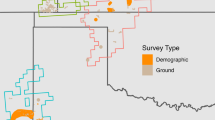Abstract
We analysed variation in age in a fluctuating population of the common vole (Microtus arvalis) in southern Moravia, Czech Republic, to test the assumption of the senescence hypothesis that the age of voles increases with increasing population density. Between 1996 and 1998, we monitored the demographic changes by snap-trapping and live-trapping in a field population passing through the increase, peak and decline phase of the population cycle. We used the eye lens mass method to determine the age of snap-trapped animals and those that died in live-traps. The average age of winter males was clearly higher after the peak phase breeding season than before it. No such phase-dependent shift in age, however, was observed in the female component. Male age continued to increase from autumn to spring over the pre-peak winter, and the highest age was in spring of the peak phase year. However, after the peak phase breeding season the highest age was achieved in winter, with the decline phase males during the next spring tending to be younger. The average age of females in spring populations was always lower than in winter populations. The average age of voles from live-traps was always higher than voles from snap-traps, particularly in winter and spring populations, suggesting the presence of senescent animals. Although the density-dependent changes in age are consistent with those observed for other voles, they provide only weak evidence that population cycles in the common vole are accompanied by pronounced shifts in individual age, particularly in female voles.



Similar content being viewed by others
References
Adamczewska-Andrzejewska KA (1981) Population structure of Microtus arvalis (Pall.) against the background of a community of rodents in crop fields. Pol Ecol Stud 7:193–21
Bergstedt B (1965) Distribution, reproduction, growth and dynamics of the rodent species Clethrionomys glareolus (Schreber), Apodemus flavicollis (Melchior) and Apodemus sylvaticus (Linne) in southern Sweden. Oikos 16:132–160
Berryman AA (1999) Principles of population dynamics and their application. Stanley Thornes, Cheltenham
Boonstra R (1989) Life history variation in maturation in fluctuating meadow vole populations (Microtus pennsylvanicus). Oikos 54:265–274
Boonstra R (1994) Population cycles in microtinae: the senescence hypothesis. Evol Ecol 8:196–219
Bryja J, Tkadlec E, Nesvadbová J, Geisler J, Zejda J (2001) Comparison of enumeration and Jolly-Seber estimation of population size in the common vole Microtus arvalis. Acta Theriol 46:279–285
Burnham KP, Anderson DR (1998) Model selection and inference. A practical information-theoretic approach. Springer, Berlin, Heidelberg, New York
Butet A, Spitz F (2001) Cyclic fluctuations of microtine populations: half a century of research. Rev Ecol-Terre Vie 56:353–372
Caughley G (1977) Analysis of vertebrate populations. Wiley, London
Chitty D, Phipps E (1966) Seasonal changes in survival in mixed populations of two species of vole. J Anim Ecol 35:313–331
Ergon T, Lambin X, Stenseth NC (2001) Life-history traits of voles in a fluctuating population respond to the immediate environment. Nature 411:1043–1045
Frank F (1957) The causality of microtine cycles in Germany. J Wildl Manage 21:113–121
Gliwicz J (1994) Why do some young voles stop growing? Pol Ecol Stud 20:335–341
Hansson L (1983) Differences in age indicators between field and laboratory small rodent populations. Mammalia 47:371–375
Ihaka R, Gentleman R (1996) A language for data analysis and graphics. J Comput Graph Stat 5:299–314
Klemola T, Korpimäki E, Koivula M (2002) Rate of population change in voles from different phases of the population cycle. Oikos 96:291–298
Koshkina TV (1965) The population density and its importance in the number regulation of red vole (in Russian). Byull M O-va Isp Prirody, Otd Biol 70:5–19
Krebs CHJ (1996) Population cycles revisited. J Mammal 77:8–24
Krebs CHJ, Boonstra R (1978) Demography of the spring decline in populations of the vole, Microtus townsendii. J Anim Ecol 47:1007–1016
Lambin X, Yoccoz NG (2001) Adaptive precocial reproduction in voles: reproductive costs and multivoltine life-history strategies in seasonal environments. J Anim Ecol 70:191–200
Mallory FF, Elliot JR, Brooks RJ (1981) Changes in body size of the collared lemming: age and photoperiod influences. Can J Zool 59:174–182
Martinet L (1966) Determination de l’age chez le campagnol des champs (M. arvalis, Pallas) par la pesse du cristallin. Mammalia 30:425–430
Norrdahl K, Korpimäki E (2002) Changes in population structure and reproduction during a 3-yr population cycle of voles. Oikos 96:331–345
Oli MK, Dobson FS (2001) Population cycles in small mammals: the alpha-hypothesis. J Mammal 82:573–581
Royama (1992) Analytical population dynamics. Chapman and Hall, London
Stenseth NCH (1999) Population cycles in voles and lemmings: density dependence and phase dependence in a stochastic world. Oikos 87:427–461
Tkadlec E, Krejčová P (2001) Age-specific effect of parity on litter size in the common vole (Microtus arvalis). J Mammal 82:545–550
Tkadlec E, Stenseth NC (2001) A new geographical gradient in vole population dynamics. Proc R Soc Lond, B, Biol Sci 268:1547–1552
Tkadlec E, Zejda J (1998a) Small rodent population fluctuations: the effects of age structure and seasonality. Evol Ecol 12:191–210
Tkadlec E, Zejda J (1998b) Density-dependent life histories in female bank voles from fluctuating populations. J Anim Ecol 67:863–873
Turchin P (1999) Population regulation: a synthetic view. Oikos 84:153–159
Zejda J (1961) Age structure in populations of the bank vole, Clethrionomys glareolus Schreber 1780. Zool Listy 10:249–264
Zejda J (1967) Mortality of a population of Clethrionomys glareolus Schreb. in a bottomland forest in 1964. Zool Listy 16:221–238
Zejda J (1992) The weight growth of the water vole (Arvicola terrestris) under natural condition. Zool Listy 41:213–219
Zimmermann K (1955) Körpergrösse und Bestandsdichte bei Feldmäusen (Microtus arvalis). Z Säugetierkunde 20:114–118
Acknowledgements
We thank Jan Zejda for his perpetual and enthusiastic support and Dana Havelková for laboratory assistance. This research was financially supported by the grant GACR 524/96/1095.
Author information
Authors and Affiliations
Corresponding author
Rights and permissions
About this article
Cite this article
Jánová, E., Heroldová, M., Nesvadbová, J. et al. Age variation in a fluctuating population of the common vole. Oecologia 137, 527–532 (2003). https://doi.org/10.1007/s00442-003-1379-0
Received:
Accepted:
Published:
Issue Date:
DOI: https://doi.org/10.1007/s00442-003-1379-0




